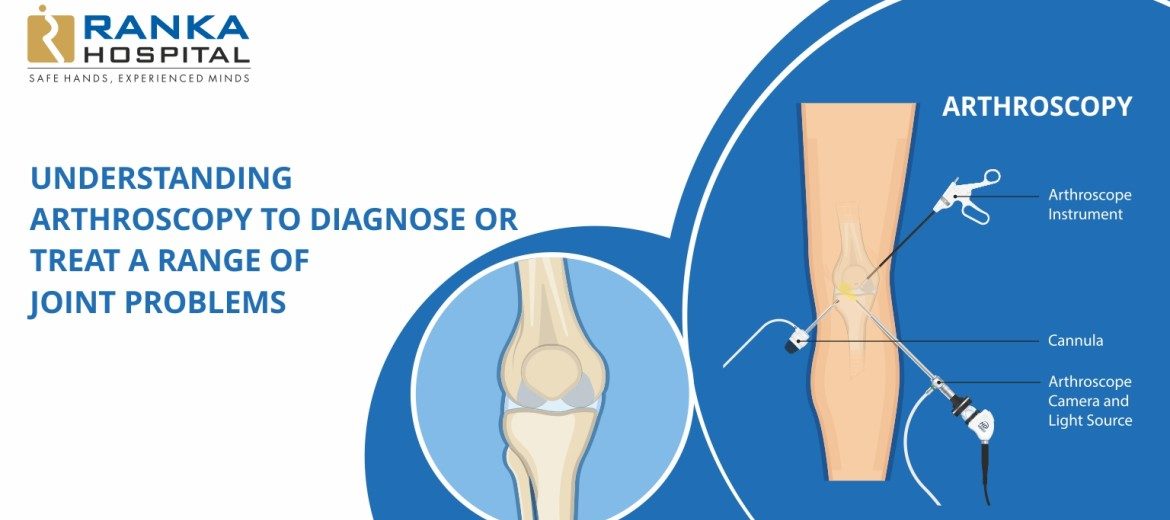Understanding Arthroscopy to Treat a Range of Joint Problems
Arthroscopy is used to Diagnose or Treat a Range of Joint Problems
Advances in medical science and technology has made it easier to diagnose certain conditions. Arthroscopy is a technological advancement that we at Ranka Hospital use to understand our patients’ conditions better. Let’s understand how arthroscopy can help diagnose and treat a range of joint problems.
What is Arthroscopy? Arthroscopy is procedure by which a doctor can take a look inside your joints, without actually having to perform surgery. This is made possible by the use of optical fibers attached to a tube. These tiny optical fibers give the doctor a view of your joints. If s/he feels the need to repair something, most often that can also be done with sophisticated needle-thin instruments. Again, this helps avoid surgery. The instruments are inserted through incisions near the area to be examined, at the most approximately a quarter of an inch in size.
What Kind of Problems does Arthroscopy detect? Many joint problems that affect areas such as the knee, shoulder, elbow, hip, ankle and wrist apart from others can be diagnosed through arthroscopy. For example, an irregular cartilage may indicate osteoarthritis or in case of a swelling the affected joint tissue can be removed with arthroscopy and examined further for the presence of infection. This method is more effective than just removing fluid with a syringe (aspiration). Meniscus and ligament tears can also be detected as can the presence of loose tissue and bone fragments. With arthroscopy, these can even be removed easily.
How is arthroscopy performed? Arthroscopy requires the patient to be under some amount of anesthesia. The amount varies depending on the patient’s condition. A fluid such as salt water may be pumped into the joint for a clearer view. The procedure begins with incisions being made near the affected area. Through these incisions the arthroscope is inserted. The surgeon can then see the inside of your joints on a monitor. Additional instruments may be used through another incision either to get a clearer view or perform a surgical repair. When the procedure is complete, all instruments are removed and the incisions are closed. The procedure is ideally completed within 2 hours.
What do you need to do to in preparation for an arthroscopic procedure? Before carrying out the procedure, your doctor will do an examination of your health. Usually if there is an infection in your body, the procedure may be delayed. You also need to tell your doctor details of any medication you may be on at the time. If you have any existing medical conditions, those must also be disclosed. Older patients may be asked to go through an electrocardiogram (EKG) and a chest X-ray. The main consideration however is that your body should be in a condition to take anesthesia. Depending on the type of anesthesia being used, you may need to fast before the procedure.
What does recovery from an arthroscopic procedure entail? Post the procedure; you will be shifted into an observation room for a couple of hours. During this time the anesthesia begins to wear off and you may feel a bit of numbness in the area and weakness in general. Usually you can leave the hospital on the same day. For a few days you will be asked to rest and keep your joint elevated and maybe even iced. Your stitches will be bandaged and you will be required to keep the dressing clean and dry. You may also be given a course of medication to keep the pain away and reduce inflammation. In some cases use of a sling or crutches maybe recommended. Within a week, you should be able to get back to light activities and some physical therapy exercises maybe advised. More strenuous activities should be attempted only if your doctor allows it.
What is not normal after an arthroscopic procedure? If anything that you haven’t been told about occurs, call your doctor immediately. These are a few things you can look out for as well:
- Fever
- Pain that doesn’t subside
- Excessive pus near the stitches
- Swelling
Arthroscopic procedures are performed by orthopedic surgeons, such as those we have at Ranka Hospital, which is one of the best orthopedic hospital in Pune. Arthroscopy minimizes the need for surgery and patients can recover faster. It is a simple non-invasive procedure that has minimum risks. Ranka Multispeciality Hospital located in Pune specializes in orthopedics and arthroscopy.

